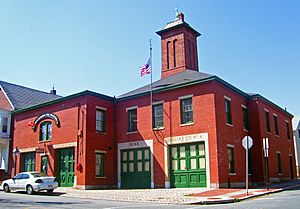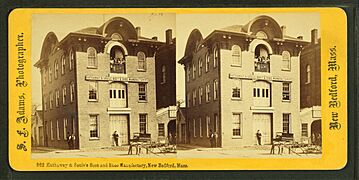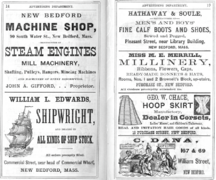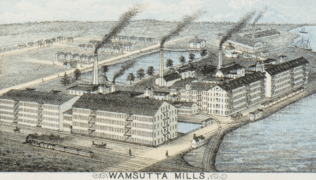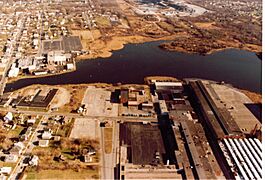Timeline of New Bedford, Massachusetts facts for kids
New Bedford is a city in Massachusetts, United States, with a rich and exciting history. It's especially famous for its past as a major whaling port, once known as "The Whaling City." This timeline will take you on a journey through the most important moments in New Bedford's story, from its early days to the present. You'll learn about the people who lived here, the industries that made it famous, and the events that shaped it into the city it is today.
Early History of New Bedford
Native American Roots and First European Visits
- Before 1602: The Wampanoag people, whose name means 'People of the Morning Light,' lived in this area. They were a Native American group who spoke the Algonquian language. Their lands stretched from Narragansett Bay all the way to Cape Cod, including islands like Martha's Vineyard and Nantucket.
- 1602: An English explorer named Bartholomew Gosnold visited the place that would later become New Bedford.
- 1652: A large area of land, including what is now New Bedford, was bought from the Wampanoag leaders Massasoit and his son Wamsutta. This land became known as Old Dartmouth. It included several towns we know today: Dartmouth, New Bedford, Acushnet, Fairhaven, and Westport.
Growth and Early Challenges
- Around 1665: Many Quakers moved to the area. Quakers are a religious group known for their peaceful beliefs and their strong stand against slavery.
- 1760: The main village of New Bedford was officially started.
- September 1778: During the American Revolutionary War, the British carried out an attack called Grey's raid against coastal towns like New Bedford.
- 1787: New Bedford officially became a town.
- 1792: The first newspaper, The Medley, began publishing. A post office also opened this year.
- 1797: The first Clarks Point Light lighthouse was built. The town's population was 3,313 people.
New Bedford in the 1800s
The Rise of Whaling and Industry
- 1804: New Bedford became a major center for whaling. There were 59 whaling ships registered from the town.
- 1812: Fairhaven separated and became its own town, no longer part of New Bedford.
- 1822: The New Bedford Meeting House, an important building for the Quaker community, was constructed.
- Late 1820s: Quakers in New Bedford became strong voices for ending slavery.
- 1830: The population of New Bedford grew to 7,592 people.
- 1832: The Seamen's Bethel, a church for sailors, was built.
- 1834: The U.S. Customhouse was built. This building was important for collecting taxes on goods coming into the port.
- September 1838: The famous abolitionist and writer Frederick Douglass moved to New Bedford. He had escaped slavery and found freedom here.
- 1841: The Charles W. Morgan (ship), a famous whaling ship that you can still visit today, was built.
- 1846: The Wamsutta Mills company was started. This marked the beginning of the textile industry in New Bedford, where cotton was turned into fabric.
- 1847: New Bedford officially became a city. Joseph Grinnell built the city's first cotton mill.
- 1848: Whaling ships from New Bedford began exploring the Arctic for whales.
City Growth and New Institutions
- 1850: The Daily Evening Standard newspaper started. The city's population reached 16,443.
- 1853: The city established a public library, which was important for education and community life.
- 1861: Fort Rodman, also known as Fort Taber, was built at Clark's Point to protect the harbor.
- 1866: The Wamsutta Club, a social club, was founded.
- 1867: Fire Station no.4 was built. Today, this building is home to the New Bedford Fire Museum.
- 1871: A major disaster occurred when many whaling ships were trapped and crushed by ice in the Arctic.
- 1884: St. Luke's Hospital was founded, providing important healthcare for the community.
- 1890: The population of New Bedford grew to 40,733.
- 1894: The Buttonwood Park Zoo opened, offering a place for recreation and learning about animals.
- 1895: The New Bedford Textile School was founded. This school trained people for jobs in the growing textile industry.
- 1899: The New Bedford – Fairhaven Bridge was built, connecting New Bedford and Fairhaven.
- 1900: The population continued to grow, reaching 62,442.
New Bedford in the 1900s
Modernization and Challenges
- 1903: The New Bedford Whaling Museum was established. This museum helps preserve and share the city's rich whaling history.
- 1906: Important improvements were completed in the New Bedford harbor, making it better for ships.
- 1910: The population reached 96,652. A major strike by textile workers happened this year, showing the challenges faced by workers.
- 1912: The Orpheum Theatre opened, providing entertainment for the city.
- 1920: The population continued to climb, reaching 121,217.
- April 2, 1923: The Zeiterion theatre opened, another important venue for arts and performances.
- 1942: The airport was built, connecting the city by air.
- 1958: A plane crash involving Northeast Airlines Flight 285 occurred at the New Bedford Airport.
- 1962: The Waterfront Historic Area League (WHALE) was organized. This group works to protect and preserve the historic buildings and areas of New Bedford.
- 1970: The city experienced some racial unrest.
- 1972: New Bedford High School was established. New Bedford also formed a "sister city" relationship with Horta in the Azores, Portugal, recognizing shared cultural ties.
- 1976: The New Bedford Fire Museum opened, showcasing the history of firefighting in the city.
- 1985: A labor strike happened between fishermen and shipowners, highlighting the ongoing importance of the fishing industry.
- 1987: New Bedford established another sister city relationship, this time with Tosashimizu, Japan.
- 1996: The New Bedford Whaling National Historical Park was established. This park helps protect and interpret the city's whaling heritage. The New Bedford Historical Society was also founded.
- 1997: The Azorean Maritime Heritage Society was organized, celebrating the strong connections between New Bedford and the Azores islands. The New Bedford Bay Sox baseball team was formed.
New Bedford in the 2000s
Recent Developments
- 2003: The Coast Guard Station New Bedford closed.
- 2010: The population was 95,072. The New Bedford Museum of Glass opened, showcasing beautiful glass art.
- 2015: The Marine Commerce Terminal began operating, supporting new industries like offshore wind power.
Images for kids

All content from Kiddle encyclopedia articles (including the article images and facts) can be freely used under Attribution-ShareAlike license, unless stated otherwise. Cite this article:
Timeline of New Bedford, Massachusetts Facts for Kids. Kiddle Encyclopedia.


